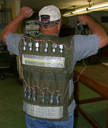 |
 |
 |
|---|
| Terrorism in Perspective Incendiary Explosive Devices |
|---|
 |
 |
 |
|---|
| Today, emergency responders and others in emergency services who support them face new challenges that seriously imperil not only the public but those very persons whose job it is to protect and help the public. The risks faced in today's world pose threats for which the average emergency responder may not be prepared. These threats go far beyond the usual ones associated with residential fires, vehicular accidents, or even hazardous materials incidents. |
| Terrorists have the knowledge and the capability to strike anywhere in the world. We have seen that when properly motivated they will do whatever they have to do in order to achieve their goals. |
| All communities--especially those in free societies--are vulnerable to incidents involving terrorism. |
|---|
| In one sense, it makes no difference to a first responder whether the incident is a terrorist act or not. You still will respond and be among the first on the scene. Naturally, the size and the kind of terrorist action are key factors. But the important point to note is that an act of terrorism is essentially different from normal emergencies. You will have to deal with a new set of circumstances far different from the structural fire, the auto wreck, even the hazardous materials incident. |
 Pipe Bomb |
|
 Suicide Vest |
|---|
| It is estimated that 70 percent of all terrorist attacks worldwide involve explosives. It is apparent that bombs are the current weapon of choice among terrorist groups. |
| Improvised explosives and incendiary devices are designed and assembled to explode and cause fires. Explosions rapidly release gas and heat, affecting both structures and people. Bombings are the types of terrorist attacks most likely to be encountered. Bombs nearly always work as designed. An important point to remember is that explosions can cause fires, and fires can cause explosions. First responders should always be aware of the potential for secondary devices. |
| In the event you are called upon to respond to a call where you will be involved with improvised explosives and incendiary devices that have not yet detonated we have provided a "Safe Standoff Distance Chart" to help you understand where the safe zone exists. |
| Improvised Explosive Device Safe Standoff Distance Chart |
![]()